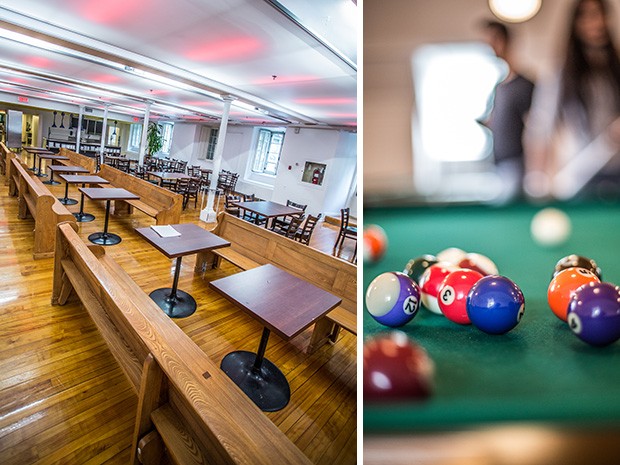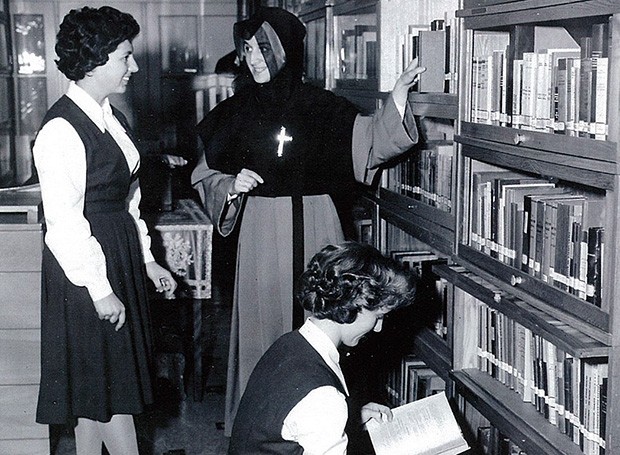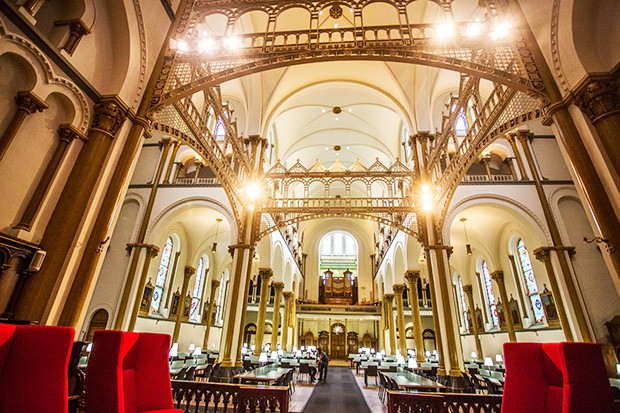The fascinating history behind Concordia’s new student residence
This term, some 600 Concordia students will move into the newly renovated Grey Nuns Building, located at the corner of Guy Street and René-Levesque Boulevard.
“It’s ironic that the latest addition to Quartier Concordia is now the oldest building on our downtown campus,” says Clarence Epstein, Concordia’s senior director of Urban and Cultural Affairs. “A new chapter in our university history begins with the repurposing of this Montreal landmark.”
The former home of the Roman Catholic Congregation of the Sisters of Charity of Montreal — also known as the Grey Nuns Mother House — was acquired by Concordia in 2007 and underwent an extensive renovation this past year.
All of the rooms and common areas in the residence have been updated. The building’s centrepiece, the Chapelle de l’Invention-de-la-Sainte-Croix, has been converted into a reading room, open to all Concordia students. Several of the larger rooms on the building’s main floor have also been converted into group study rooms.
On a quiet Monday morning earlier this summer, Sisters Rose-Alma Lemire and Nicole Fournier returned to take a tour of their congregation’s former home.
The two sisters first came to live in the Mother House in the late 1950s, when they enrolled as students in the École Normale des Soeurs Grises, the congregation’s teacher-training school.
At the time, the building was a hive of activity. Students, members and prospective members of the congregation, and visitors filled the long hallways, remembers Sister Fournier. “There could be 1,000 people in the building on any given day.”
Devoted to charity
The Grey Nuns congregation was founded in 1737 by Marguerite d’Youville, a widow and mother of two. In 1871, the congregation moved from Old Montreal into the Mother House, designed by renowned architect Victor Bourgeau.
At the time Sisters Fournier and Lemire first lived in the building, it housed three schools and a seniors residence, as well as numerous offices dedicated to the Grey Nun’s local, national and international charitable efforts.
The large edifice was remarkably self-sufficient. It had a pharmacy, infirmary, workshops, sewing rooms and even a dental clinic. “We had almost everything we needed inside here,” Sister Fournier says.
The residents also took care of all the menial jobs. Standing at the top of the building’s main central stairway, Sister Fournier recalls having to clean it every day during her time as a novitiate. “After eating our breakfast, we all had our jobs to do, and that was my job.”
Sister Lemire remembers racing up and down those same stairs at top speed when she was a young student. “When I got to the top, the director would say, ‘Go back down. You forgot your guardian angel!’ ”
Walking down the hall on the third floor, the sisters point out the former locations of classrooms and dormitories for students in the École Normale. Sister Fournier says, after finishing her studies, she decided to enter the novitiate and devote her life to the congregation’s charitable mission. “I felt it was worthwhile to renounce family life and my own career, and to consecrate my life to helping the most poor and helpless.”
After becoming a member of the congregation, Sister Fournier taught for five years in Quebec and 13 years at the Collège de Mazenod in Cameroon. The posting was part of the Grey Nuns’ mission to help improve health care, education and social development in various African nations.
Sister Fournier returned to Quebec in 1985 to assume the role of executive director of the Accueil Bonneau homeless shelter, a position she held until 2006.
Sister Lemire taught for several years, too, but was forced to change vocations when her voice failed her. During her novitiate, she was offered a temporary post with the congregation’s general administration, located at that time in the Grey Nun’s Building. When the secretary she was replacing didn’t return, the position became permanent. “They put me there for two months, and it’s now been 50 years!” she says.
A new vocation
Standing in the Chapelle de l’Invention-de-la-Sainte-Croix, the sisters point to the pews where they sat as students in the École Normale and later as novices. “During Sunday mass, it was full to bursting,” Sister Fournier recalls.
The chapel was restored in the late 1990s. In the last few months, as part of its conversion into a silent reading room, most of the pews have been replaced with long tables and chairs, and a semi-circle of plush, red armchairs occupies the space in front of the marble alter. Otherwise, everything is exactly how it was.
“For us it was a real jewel,” Sister Fournier says. “We’re happy that we were able to give it [to Concordia] in such good condition,”
The west wing of the Grey Nuns Building has been used by Concordia as a student residence since 2007. In March of 2013, the last of the sisters relocated to a new residence in Montreal’s East End, and Concordia took over the remainder of the building.
Standing at the back of the large community hall, located on the main floor near the chapel, the two sisters reflect on the building’s change in vocation and their congregation’s departure.
“I felt it was a good decision,” Sister Fournier says. “The house had become much too big for us. Life has changed a lot, and for it to become a place dedicated to the education and training of young people is great. It remains in the public service, and that consoles us.”
Sister Lemire nods in agreement. “We knew that we wanted it to serve a function for society. It was always a place for training and it will continue to be so. Also, it’s quite pretty and peaceful.”




